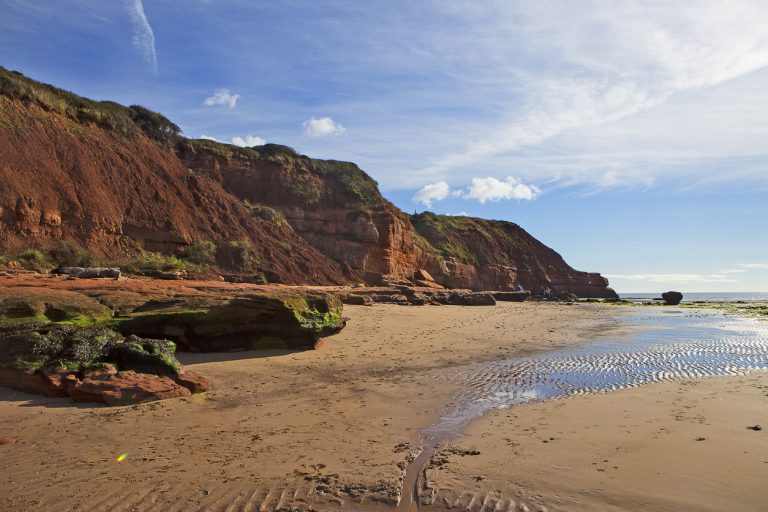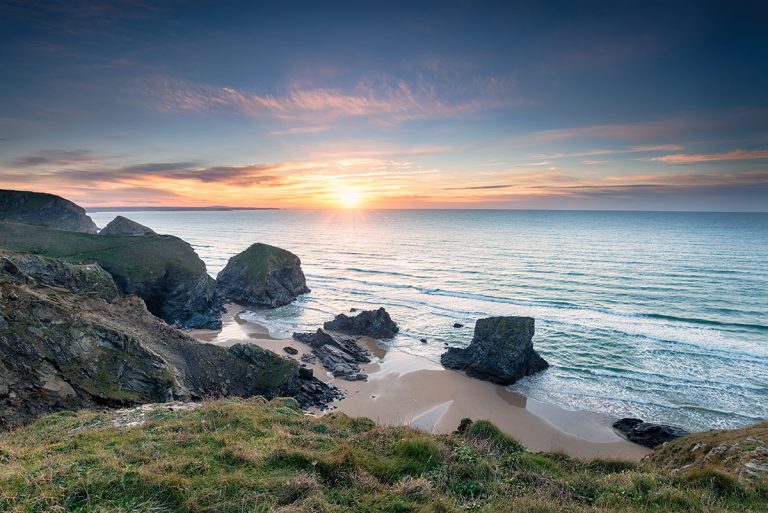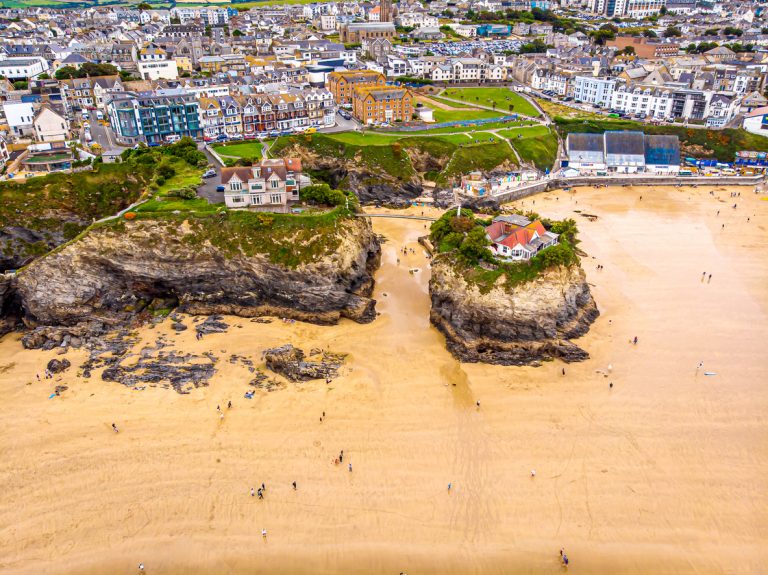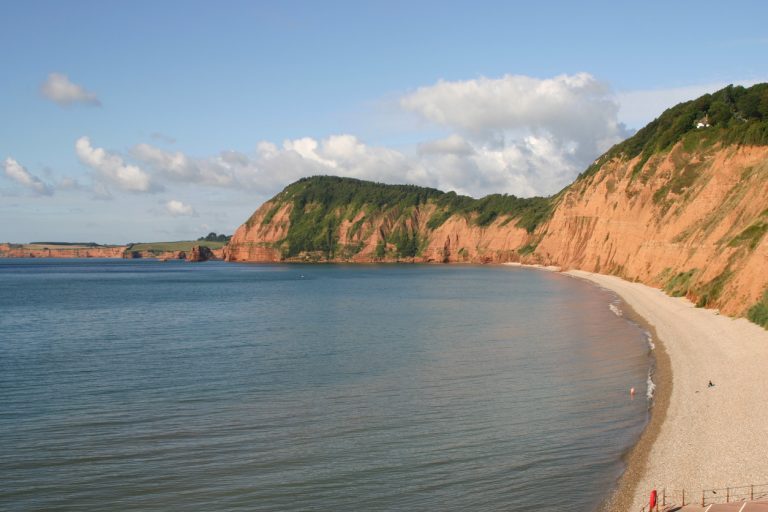Hiking in Cornwall: Best trails, packing list & tours
Are you looking for a guide to hiking in Cornwall? After spending months hiking around this region, I’ve put one together for you!
With a dramatic Atlantic coastline that wraps ruggedly around the region, plus a somewhat foreboding yet enchanting moorland in the centre, it’s no surprise that hiking is one of the best things to do in Cornwall.
While most tourists visit the region to flop on its beaches (and I don’t blame them – the beaches in Cornwall are really something special), I believe that the hiking trails are the best way to see Cornwall’s beauty.
And, what’s even better – you don’t need a 25C summer day to check out the best Cornwall hikes. You can hike in winter or when it’s cloudy – I just don’t recommend some hikes when it’s windy, foggy or torrential rain.
This makes hiking a fabulous year-round activity in Cornwall!
I spent a summer hiking the Cornish coast path, and I’ve completed many other inland hikes throughout my life too.
So, I thought I’d put together this immense hiking in Cornwall guide to help anyone who’s thinking of planning a trekking holiday to the South West region.
I live just over the River Tamar in Devon, but my family are Cornish, so I’ve spent a lot of my life in the furthest South Westerly county in Britain.
So, here’s everything you need to know about hiking in Cornwall!
What’s hiking in Cornwall like?
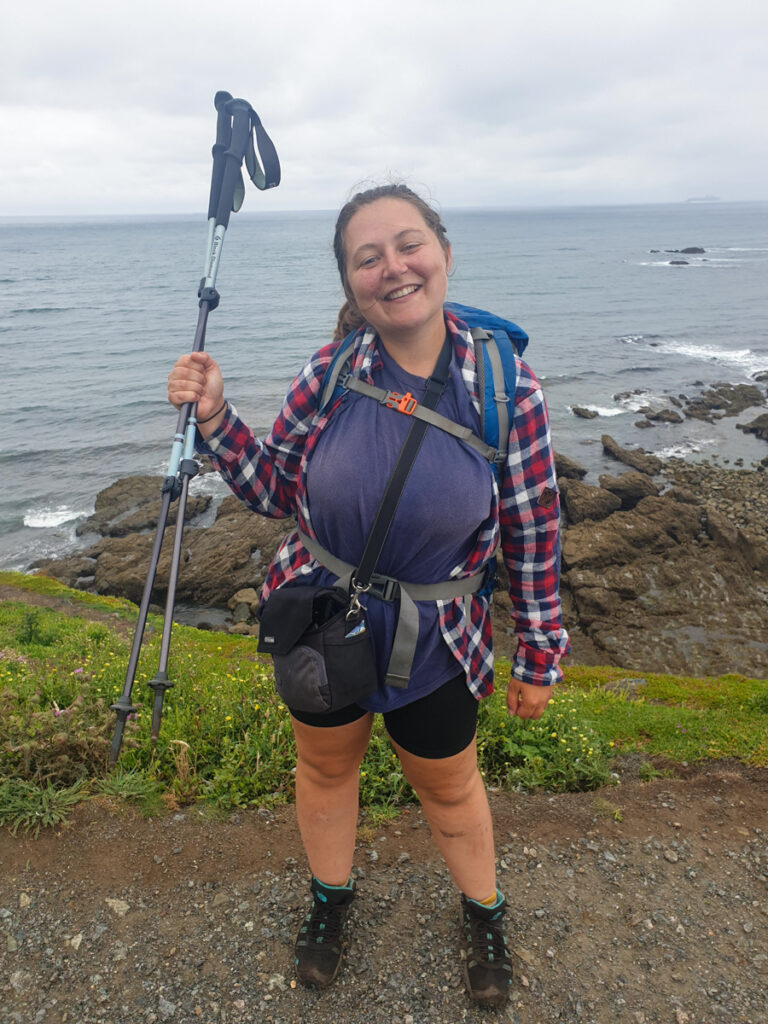
Cornwall is excellent for hiking.
It has a phenomenal section of the South West Coast Path (I’m tempted to say “the best section”, but I’ll get in trouble with people back in Devon if I do!), along with gorgeous inland countryside scenery.
If you fancy clifftop walks, then Cornwall is definitely the place to visit. But it also boasts scenic riverside strolls, hills to climb up and barren moorland to peruse…
Where to go hiking in Cornwall
Cornwall’s made for hiking, and the best trails include the Looe to Polperro, Rame Head and Tintagel to Boscastle hikes on the South West Coast Path, along with inland walks on Bodmin Moor, the Camel Estuary and the Saint’s Way. There are hiking trails for all levels, and most of them are dog-friendly too!
The Cornish Coast Path
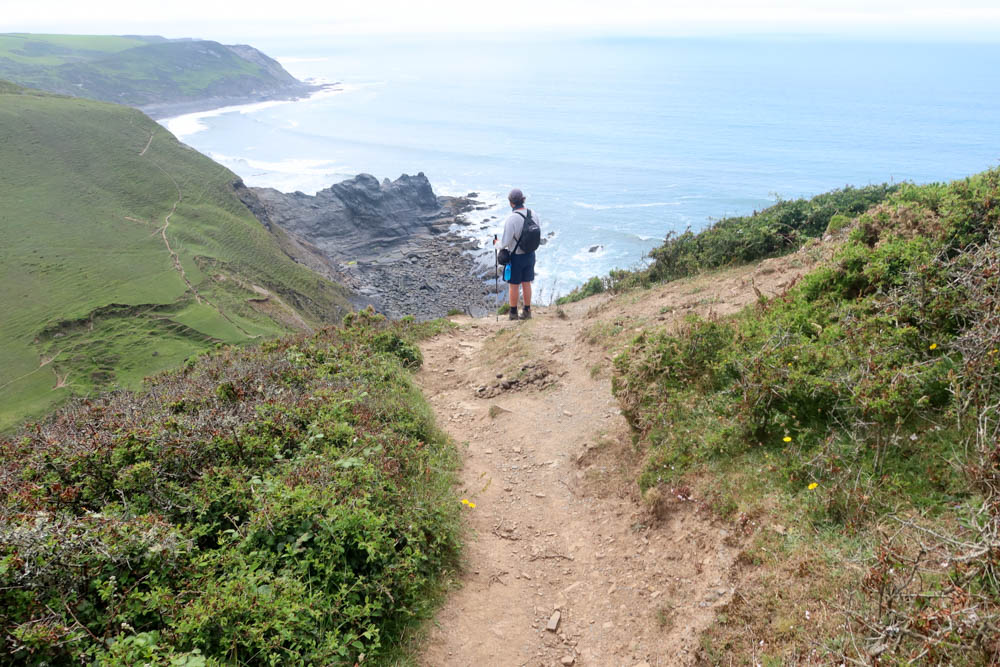
The Cornish Coast Path is part of the South West Coast Path national trail.
It stretches 330 miles from near Morewenstow in the north, all the way to Land’s End and around the tip of the country, to Cremyll which is right by the Tamar Estuary.
It’s varied, with some parts resembling a rollercoaster, and others being a gentle amble along low cliffs, beach walking or even short jaunts inland to cross rivers.
By hiking the Cornish coast path, you’ll visit every beach town and village in the Duchy and the wild stretches of coastline in between!
It takes a while to complete – it took us about a month to get from the Devon border to the Lizard Peninsula (although we were going slow and stopping a lot), and then we returned back for a few different trips for the rest.
BUT, if we were going quicker, it would take about 3-4 weeks to complete the whole thing (which is about the average).
But if you don’t have that long, don’t fret.
I’ve put together a list of the best coastal hikes in Cornwall to help you choose which ones to visit.
I’m also working on creating individual blog posts for each of these hikes – some are already complete and I’ve linked them below.
Best coastal hikes in Cornwall
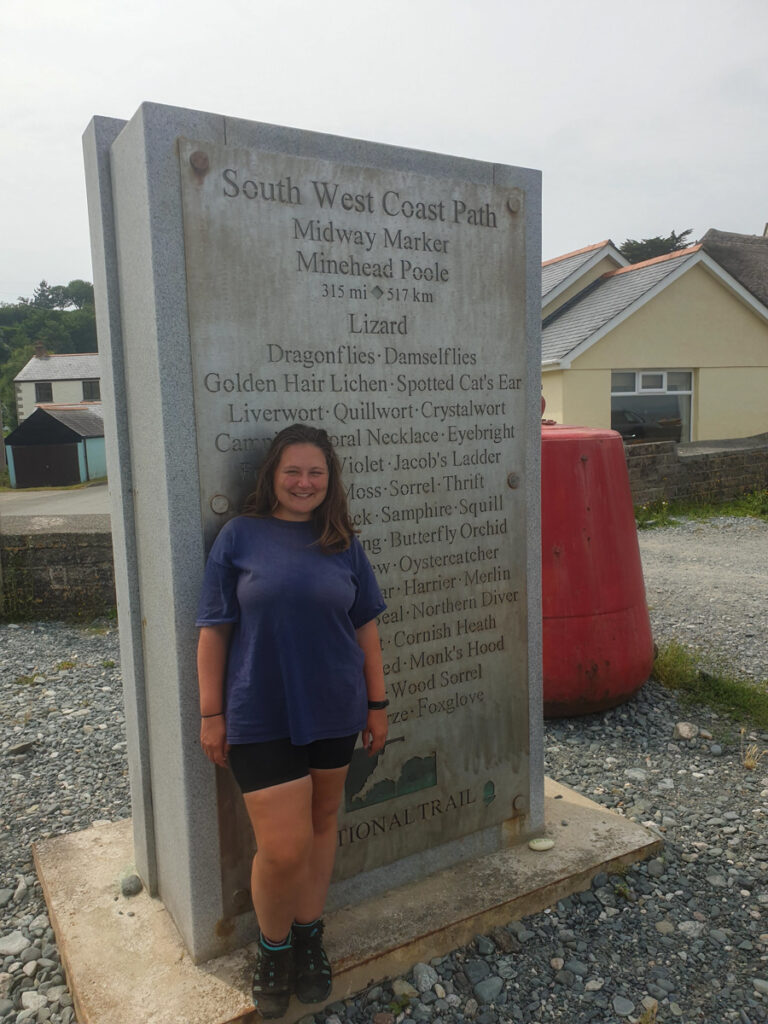
There’s something incredibly special about the turquoise waves and white sand beaches of Cornwall’s stunning coastline.
The coastal path is without a doubt one of the best things to do in Cornwall, and I’d highly recommend at least one hike on it while you’re in the region.
I’ve hiked the entire Cornish coastal trail, and here are my favourite ten walks along it.
Hartland Quay to Bude

This hike technically starts in Devon, but there’s no way I could write about the best South West Coast Path hikes in Cornwall without including it.
Hartland Quay is the start of a beautiful but ruthless heritage coastline where the coastal path undulatingly ascends and descends between valleys and summits.
Somewhere between all of the climbs and drops, after the quaintly and appropriately-named village of Welcombe, you’ll enter Cornwall.
It’s a 15 mile odyssey, and thanks to the tough terrain, it will take you all day. When we limped into Bude at around 7:30pm, all I could think about was a foot bath!

However, as you might expect, the views of this part of the Atlantic Ocean are phenomenal, and you’ll very likely have them all to yourself.
It’s tough to get back to the trailhead, so if you aren’t doing the Hartland Quay to Bude walk as part of a longer coastal path voyage, I’d recommend just walking between Morwenstow and Bude and taking the 217 bus on the return journey.
Here’s my Hartland Quay to Bude walk guide.
Looe to Polperro
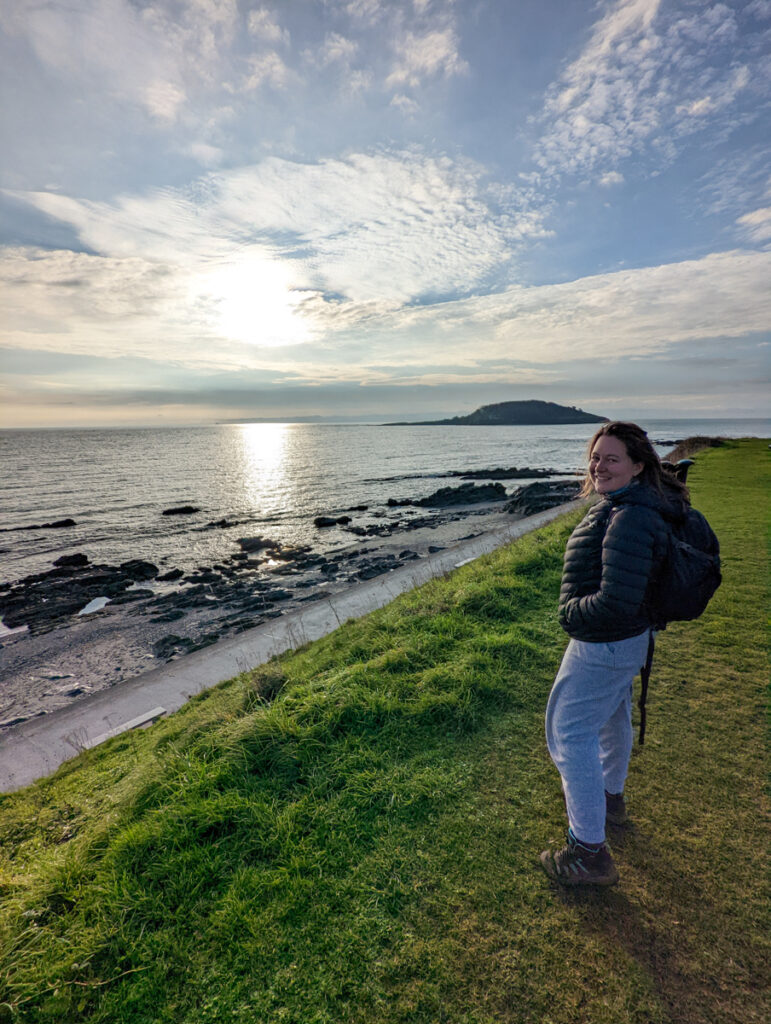
I absolutely love this fairly quick and not too challenging hike in South Cornwall.
Running from Looe, an estuary-based holiday town to Polperro, one of the most adorable fishing villages in Cornwall, it encompasses river views, scenes out to Looe Island, a little up and down (although nothing compared to other sections!) and rugged cliffs, all in the space of five miles.
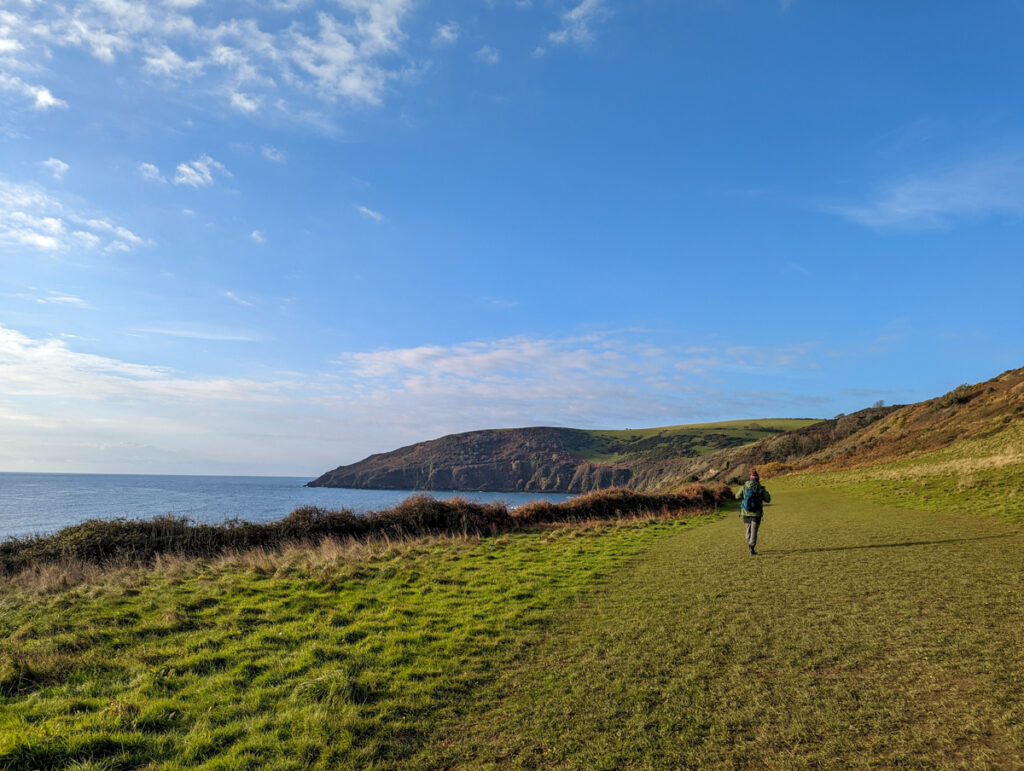
It took us around two hours, although we were stopping frequently to take pictures and notes.
Fairly frequent (as in every hour or so) buses connect these two coastal settlements.
Check out my full walking guide here.
Tintagel to Port Isaac
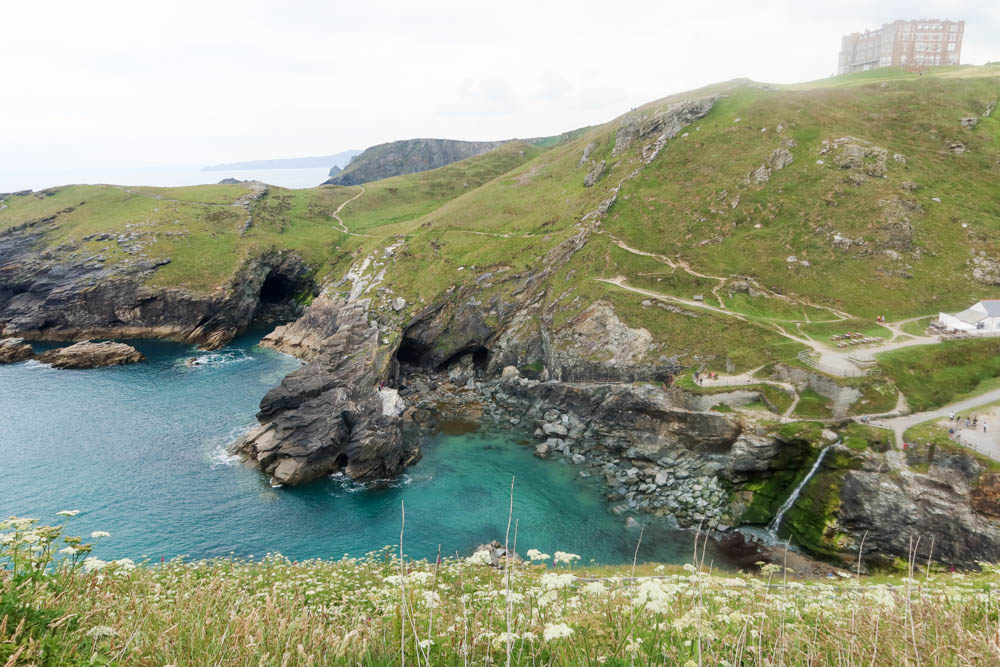
One of the more challenging parts of the South West Coast Path, this trail leads from Tintagel Castle, the alleged birthplace of King Arthur, to Port Isaac, famous for being the home of Doc Martin.
I’ll refrain from calling them both “two Cornwall legends”, but there’s something incredibly satisfying about walking between two such popular places in the Duchy!
It’s 9.1 miles, and while we didn’t find it quite as tough as the Hartland Quay to Bude hike, it was definitely up there in the most challenging sections for us.
There aren’t any direct buses from Tintagel to Port Isaac, but you could change buses in Camelford.
Just check bus times if you do, as they don’t always match up and you may have a wait in Camelford (good news is that there are a few pubs in town!).
Porthcothan to Newquay

It’s a lot more touristy than other sections of the path, particuarly on the approach to Newquay, but I just adore the Porthcothan to Newquay walk.
Bedruthan Steps is a South West Coastal Path highlight. They are famous rocky outcrops that jut out from the coastline.
Run by the National Trust, they’re popular with tourists, although most park in the National Trust car park and see them while driving around Cornwall.
As soon as you hike a little either side you’l find far fewer tourists, until you hit Mawgan Porth, then Watergate Bay (two stunning Cornish seaside towns), and finally Porth and Lusty Glaze, two beautiful beaches on the outskirts of Newquay.
It’s 10 miles in total and not too challenging. The Atlantic Coaster bus connects Newquay and Porthcothan in the summer months.
Perranporth to St Agnes
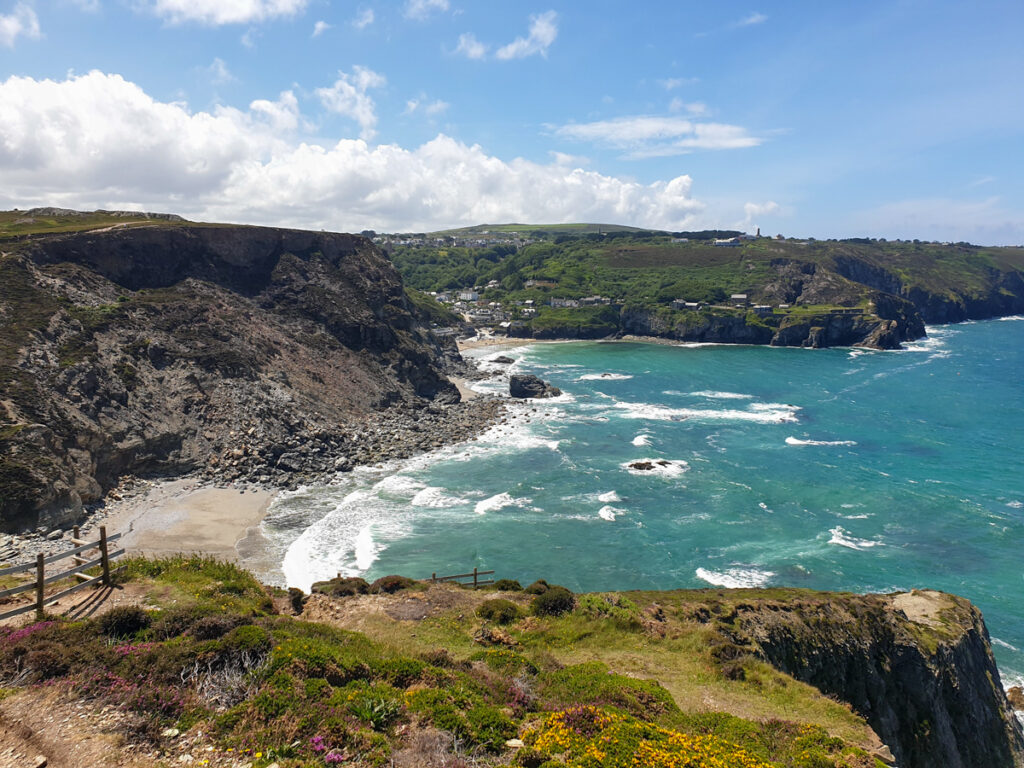
Perranporth is close to Newquay, and is famous for its long, expansive beach running alongside the cliff paths.
You can walk from Newquay to Perranporth, which traverses past beaches like Poly Joke (my Cornish dad’s favourite) and Holywell Bay (which I personally love).
However, I prefer the Perranporth to St Agnes walk. While this is shorter (some people actually manage to hike all the way to Portreath, the next village along, in a day), it’s a mining heritage coast, with incredible scenes of old mining buildings.
It’s only 3.8 miles between the towns, but you can elongate the hike by walking around St Agnes Head to Wheal Coates, where there’s a famous historic mine, before looping back around into the village.
The hike is fairly easy, with just a few ups and downs.
Once you reach one end, the Atlantic Coaster connects the two towns.
Lelant to St Ives
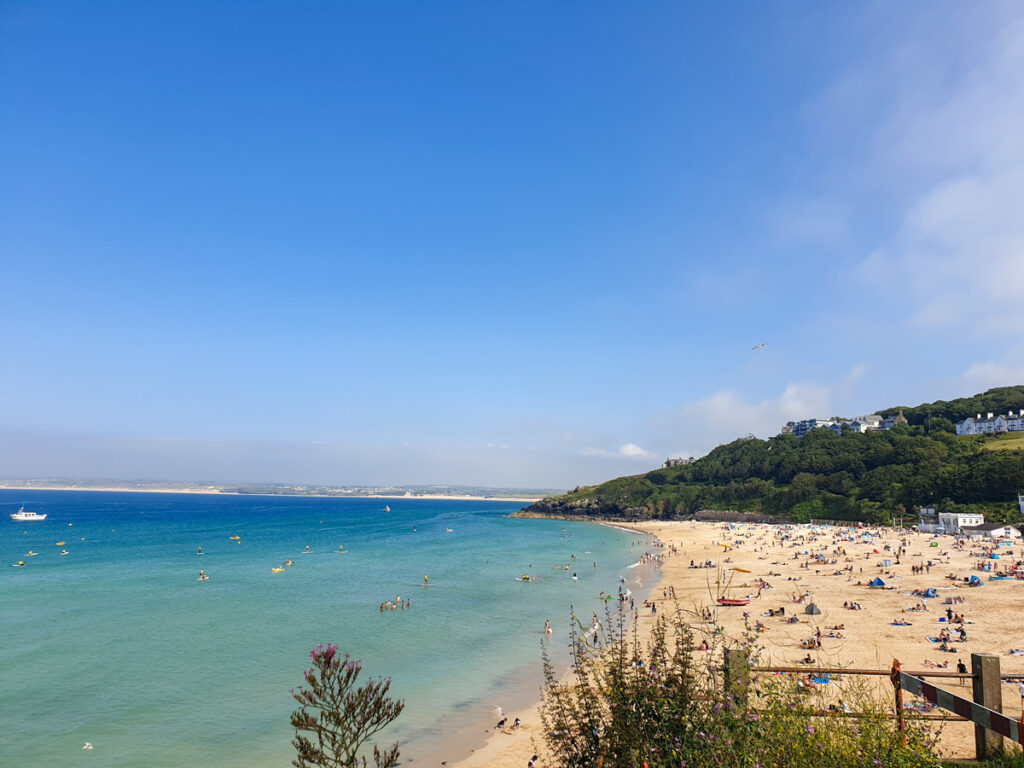
For an easy, fairly flat South West Coast Path hike, check out the Lelant to St Ives route.
This hike traverses Hayle Estuary, then all of the main beaches in St Ives and Carbis Bay, with glorious views over the white sands and palm trees – the coast around this area seriously could be in the Caribbean.
It’s 4.7 miles in total, and should take you around one hour and a half. When you get to one end, you can simply take the train back to the other.
St Ives to Zennor
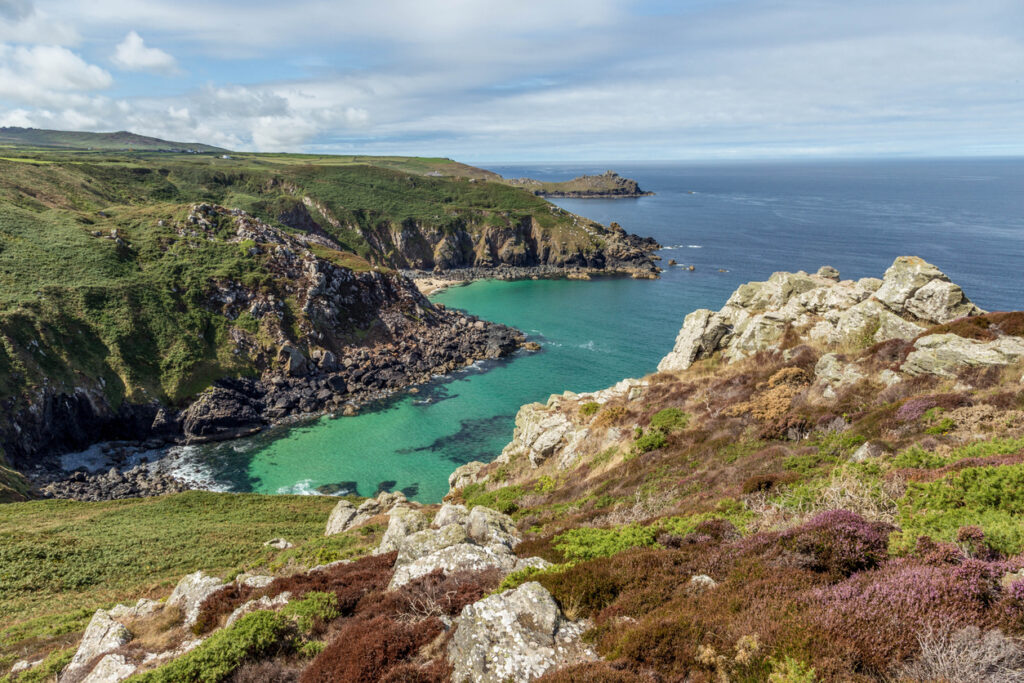
There are two excellent hikes out of St Ives, and I couldn’t leave this one out – although it’s much more challenging.
The St Ives to Zennor hike is one of the most difficult on the coastal path, with a few ups and downs and some serious scrambling at one point – but the scenery in West Cornwall is unlike any other in the country.
Plus, the hike’s not too long, at six miles – and you can look forward to a pint in the Tinner’s Arms (an immensely popular Zennor pub) at the end!
If you want to elongate your walk, you could hike all the way to Zennor Head, an outcrop with sweeping views over the sea and back towards land, or there are trails leading from the coastal path to Zennor Village.
From Zennor, either walk back through pretty countryside scenery by following this route or take the Atlantic Coaster bus back.
Pendeen to Lands End
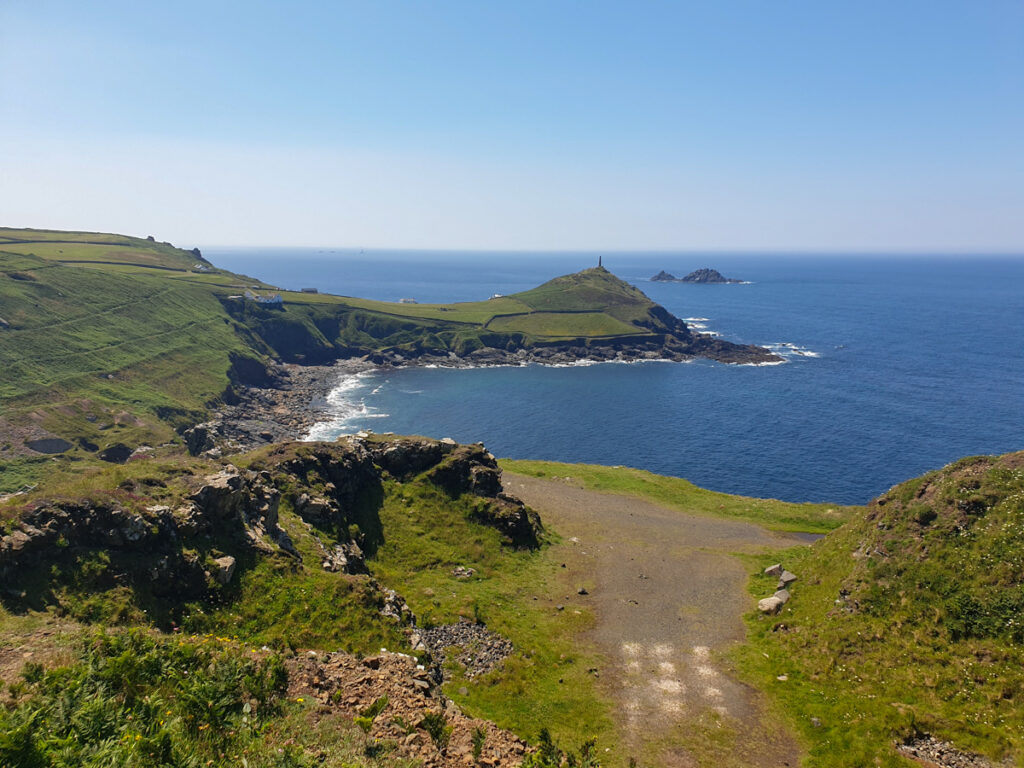
Right at the tip of Cornwall, this hike takes you through yet another mining heritage site – Pendeen is home to the Geevor Tin Mine Museum which is one of my favourite hidden gems in Cornwall.
You’ll see the rocky coast, take in some incredible beaches with barely any tourists on them, traverse Cape Cornwall, once believed to be the most southwesterly point in the country, and eventually drop down to Sennen Cove.
This is a popular seaside resort and one of the best places for surfing in Cornwall. There are a few pubs and a beach cafe to enjoy refreshements here.
From Sennen Cove, follow the path for a short distance to reach Land’s End – the end of the country.
You can see my Sennen Cove to Land’s End hiking guide here.
There are quite a few things to do at Land’s End, but some of them are quite commercial.
If you have time, I’d recommend walking even further, to Nanjizal Beach – the tourists don’t make it this far, and it’s one of my favourite beaches in Cornwall.
Kynance Cove to Lizard Point
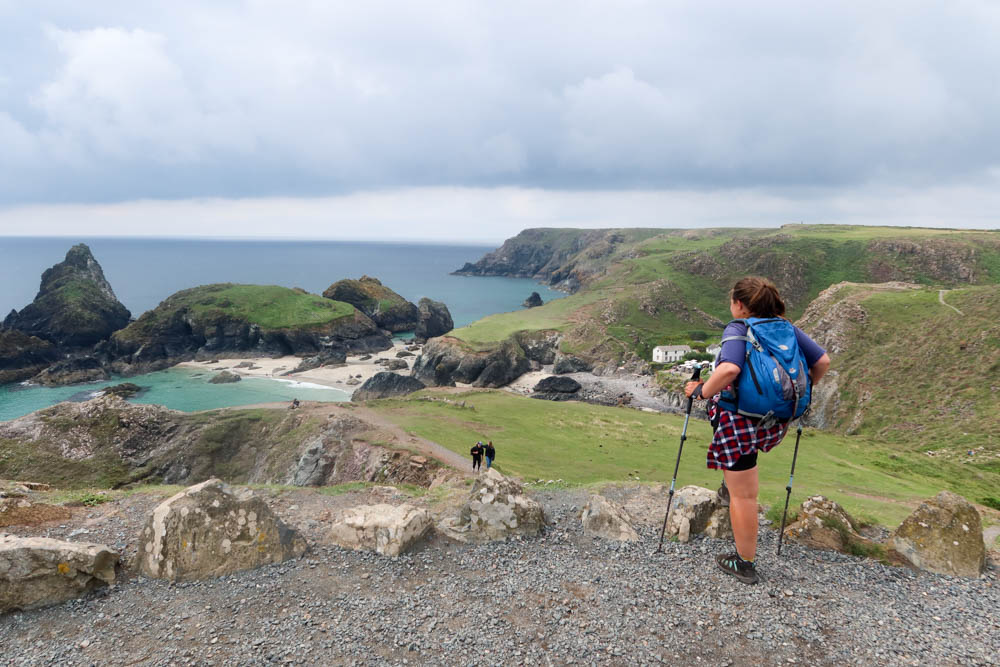
Kynance Cove to Lizard Point is a short, fairly busy hike on the Lizard Peninsula. If you’re looking for short hikes in Cornwall, this one takes in one of its best beaches and the most southerly point in the UK – quite a good bucket-list hike if you ask me!
Leaving the shores of Kynance Cove, which is renowned for being one of the most stunning hidden coves in the Duchy, (although it’s really not that hidden anymore – it had to close multiple times in the summer of 2021 due to overcrowding and Visit Cornwall stopped promoting it in 2018…) you’ll walk up and down some moderately challenging coastal path before reaching Lizard Point.
From here, you can walk inland to Lizard, the most southerly village in the UK, and have a drink at the Top House Inn, the most southerly pub in the UK.
If you want to make it a loop walk, there are trails running through the Lizard, so it’s easy to do so. The Lizard Bus links Helston with Lizard and other parts of the peninsula, including Mullion and Cury.
Check out the best walks on the Lizard by clicking here!
Polruan to Looe

While I do tend to favour the north coast of when it comes to hiking in Cornwall (those ups and downs are challenging, but they sure are rewarding!), some of the South Cornwall hikes are just as stunning.
One of these is Polruan to Polperro (or, if you want to do a longer hike, Par to Polperro).
This walk encompasses the gorgeous National Trust-owned beaches of Lantic Bay, Llansallos Bay (which is complete with a waterfall!) and Lanivet Bay.
It’s only a seven-mile walk – although it’s a bit challenging – it’ll probably take you all day, as you’ll want to stop on these gorgeous beaches.
And you absolutely should – as they’re quite difficult to get to for non-hikers, they are amongst the best in the Duchy.
Once you reach Polperro, the 481 bus leads back to Polruan. You could also hike further to Looe; the 481 bus also runs from here.
Rame Head to Cawsand

Known as “forgotten Cornwall”, the Rame Peninsula is home to dramatic cliffs and sleepy coastal villages, that remain fairly quiet even during the busy summer season.
You can enjoy all of this by doing the Rame Head to Cawsand/ Kingsand walk.
This is a small section of the South West Coast Path and you could walk all the way to Cremyll, which sits opposite Plymouth, if you prefer.
However, when we did it, we left our car at Rame Head and walked to and from Cawsand and Kingsand.
It’s about 2.5 miles each way, and there’s a great selection of pubs in the twin villages to stop off mid-hike!
Best non-coastal hikes in Cornwall
A lot of Cornwall fans (me included) are guilty of spending a lot of time on the coast and not enough time exploring the county’s incredible interior.
There’s a variety of excellent non-coastal hikes in Cornwall, and although they’re not quite the same as the dramatic coastal path, they’re beautiful in their own right!
Here are a few non-coastal hikes that you could attempt while on your Cornish holiday.
Brown Willy and Rough Tor Summit

Don’t laugh, but Brown Willy is the highest peak in Cornwall.
Its name actually comes from the Cornish word for “Hill of Swallows” (Bronn Wennill), which has been Anglicised over the years to become “Brown Willy”.
Despite it being the highest point in the Duchy, it’s no Everest and is fairly easy to summit. Sitting on Bodmin Moor, this hill is 420 metres, and you can enjoy epic panoramic views from the top.
Rough Tor is the second-highest peak in Cornwall, at 390 metres, and sits right next to Brown Willy.
This means that, if you’re up for a bit of ascending and descending, it’s completely possible to summit both on the same hike.
This walk is 5.2 miles in total and ascends both hills and traverses around the rugged terrain of Bodmin Moor.
Golitha Falls and Siblyback Lake

If water’s more your thing, there’s a gorgeous loop walk where you can take in Golitha Falls – among the best waterfalls in Cornwall – and the ever-blue Siblyback Lake.
This circular walk is 6 miles in total (including walking around the whole lake) and starts and ends in Golitha Falls. It’s an easy walk and is suitable for families.
Minions and Cheesewring
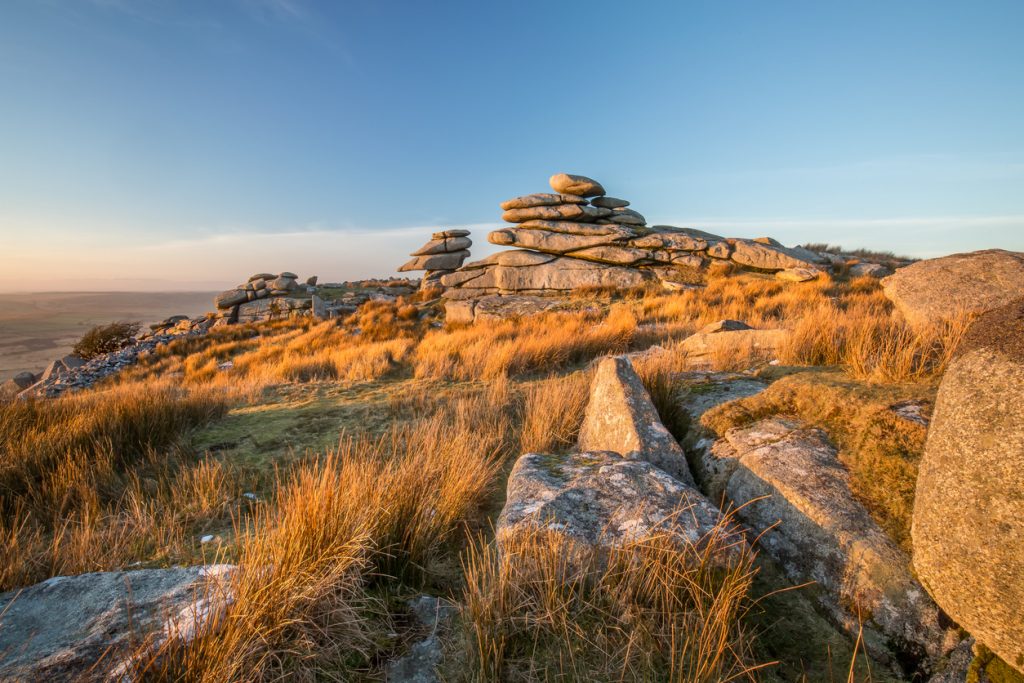
Bodmin Moor is full of fascinating ancient monuments, including stone circles and mounds.
The Hurlers dates back to the Bronze Age and Cheesewring is a stack of rocks on a tor, taking its name from local equipment that was used to make cider.
This moderate walk is just 3.4 miles in total, and starts and ends in the village of Minions, which is home to the highest pub in Cornwall!
(While Minions is nothing to do with the Despicable Me film – its name was derived from the Cornish word “menyon” which means stones, they’ve definitely cashed in on the little yellow characters!).
En route, enjoy remnants of Neolithic Cornish life, mind-blowing views across the moorland and engine houses of mines.
Lanhydrock to Restormel

Two of Cornwall’s beautiful historic sites, one country house and one castle, Lanhydrock and Restormel actually only sit a short distance from one another.
You can take them both in on a five mile loop walk, starting in the Lanhydrock Estate (it’s free to enter the estate, but if you want to see the house and gardens you’ll need to pay or have a National Trust membership).
The walking route weaves to Restormel, before heading back to the Lanhydrock Estate. Of course, if you buy a ticket or have an English Heritage membership, you can visit Restormel Castle too!
Smugglers’ Way
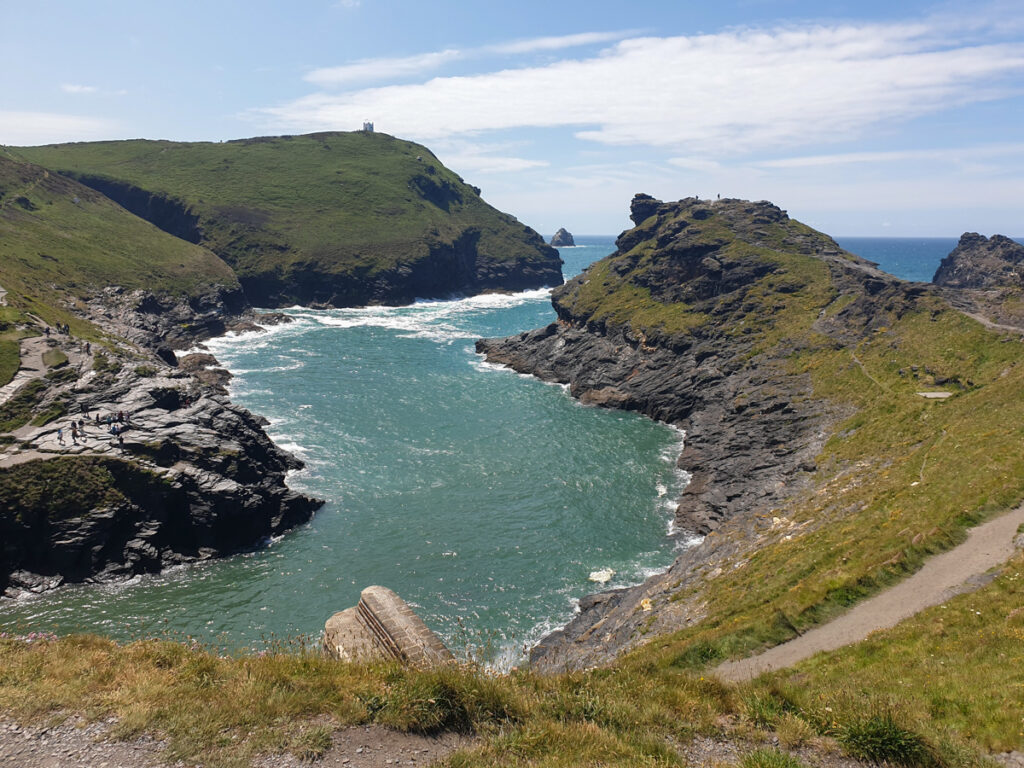
If you want to learn more about Cornish history and heritage while trekking across some of its most least-visited parts, Smugglers’ Way is for you!
It runs from Boscastle to Looe, stretching from coast to coast while spanning through Bodmin Moor.
The trail calls in at Jamaica Inn, Sowden’s Bridge and Rough Tor.
It’s loosely based on the routes that smugglers took after taking contraband from the coast, and a visit to the Jamaica Inn smuggling museum (and a night’s stay at the inn!) is highly recommended.
This is a difficult trail in a few sense of the word.
The terrain is hilly and navigational skills are essential when crossing the moor. You shouldn’t attempt walking on Bodmin Moor during poor weather – fog makes it easy to get lost.
The trail is 37 miles in total.
Saints’ Way

Saints’ Way is another north-to-south trail, running from Padstow in the north to Fowey in the south. Unlike the smugglers’ way, this trail is marked.
This trail is actually part of the much more famous Santiago de Compostella in Galicia; it follows the route of Christian pilgrims who journeyed from Ireland and Wales to the route.
Beginning in Padstow, it follows the Fowey River and usually includes an overnight stop in Bodmin. It’s 27 miles in total.
Tamar Valley Trail
As the name implies, the Tamar Valley Trail follows the end of the River Tamar, which runs from Plymouth in the south to near Bude in the north.
In fact, the River Tamar would cut Cornwall off from England if it wasn’t for the six miles between the border and the northern coastline!
There’s a trail running all the way up the Tamar Valley, but I particularly love the section from Calstock to Gunnislake, which is around six miles and is fairly flat.
You can take trains in between the two settlements, which lead all the way to Plymouth.
Carn Brea and Great Flat Lode
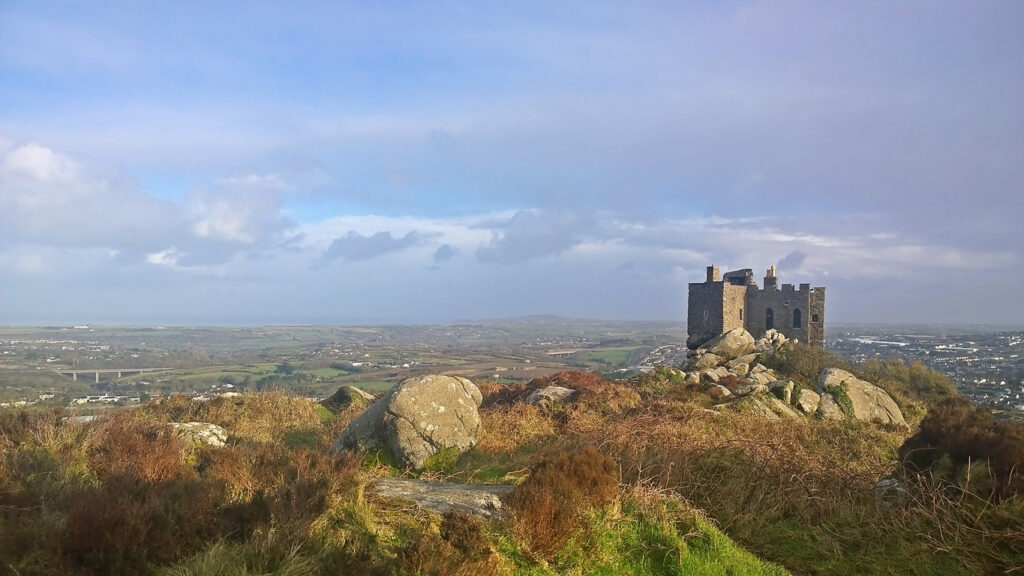
An interesting historical walk near Redruth and Camborne, this walking route traverses along the Great Flat Lode and Wheal Basset, which was where the Basset family made a fortune by owning mines.
As my ancestors were miners in this area, I find this especially fascinating!
You’ll also walk up to Carn Brea Castle, which dates back to Elizabethan times and is nowadays a restaurant.
The total route is just under six miles.
Trebarwith Valley
Trebarwith Valley is a lush area of woodland and waterfalls; it’s an AONB and a fairly uncommmon site in Cornwall (there isn’t much woodland on the peninsula).
This 2.7 mile circular walk is fairly easy and takes in bluebell woods, the charming stream and epic views of the valley.
Lelant to St Michael’s Mount (Pilgrim Route)
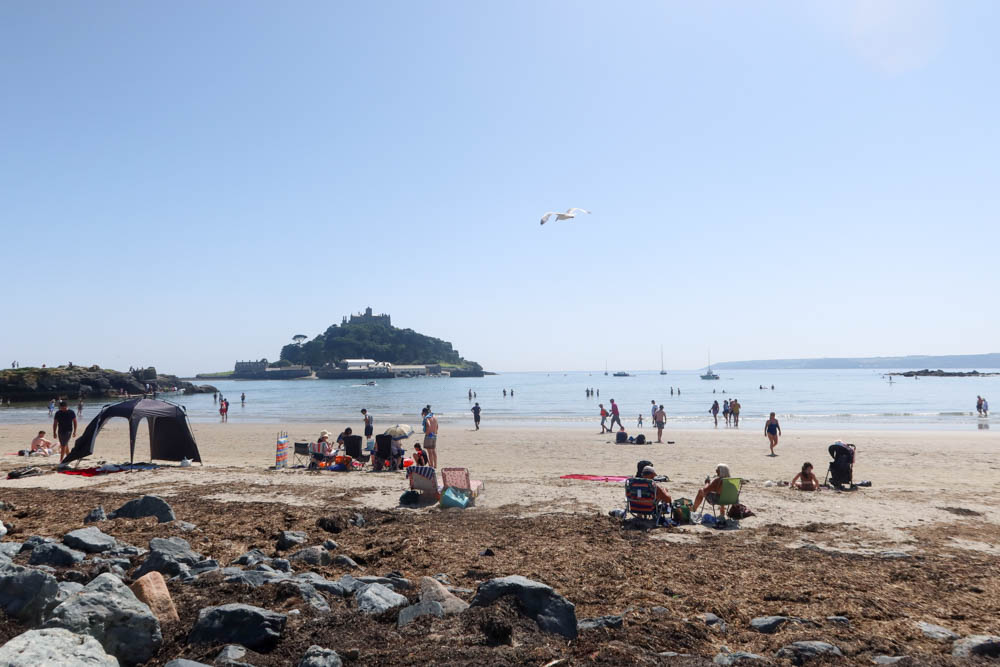
This part of the Pilgrim Route is another part of the Santiago de Compostela, running 12 miles from the northern to southern Cornish coast.
Dating back all the way to 10,000 BC, you’ll walk through history as you traverse this incredible route.
You’ll walk up Trencrom Hill, where you can enjoy views of the Hayle Estuary and coastline, before descending back down towards the south coast.
End the trail at St Michael’s Mount, which is well worth visiting if it’s open!
Where to stay when hiking in Cornwall
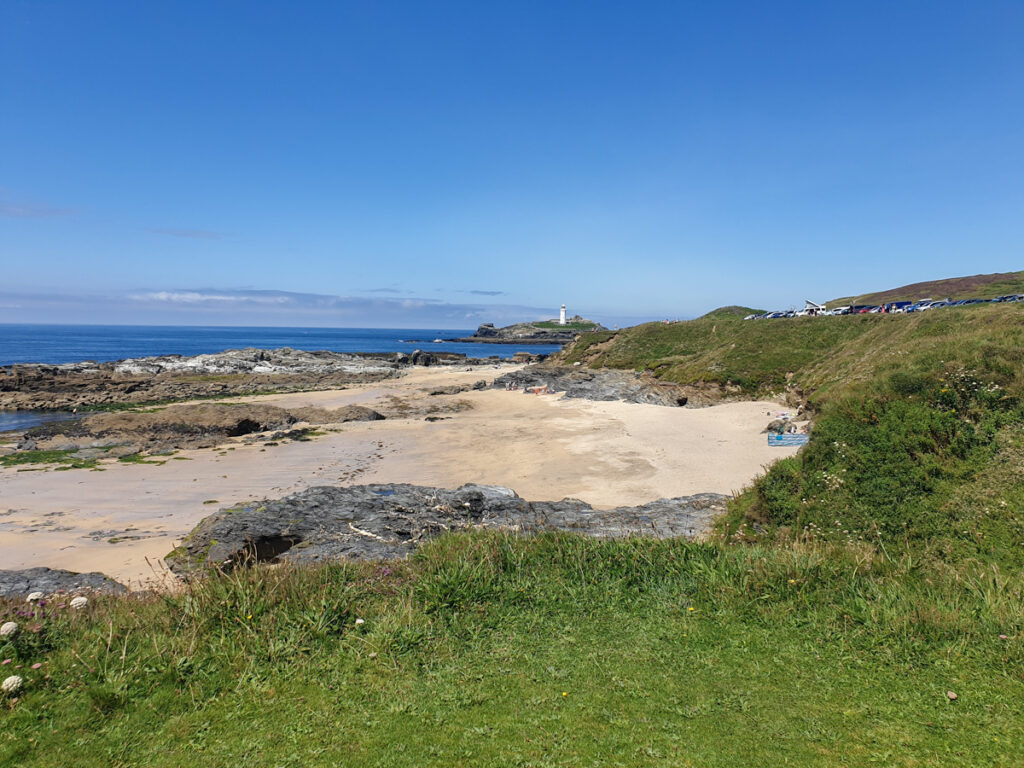
If you’re planning a Cornwall hiking holiday, you might be wondering where exactly to stay.
You can do your hiking trip in one of two ways:
- Stay in one town and do hikes in the area or areas where you can easily reach by driving or public transport.
- Hiking from town to town each day, either staying in hotels or camping. This is a popular option for people hiking the South West Coast Path.
Let’s look at both options, and you can decide which is best for you!
Best towns to stay in for Cornwall hiking
The benefits of staying in one town are that you won’t have to keep packing up every day, and you can explore the area more deeply.
It’s a good option if you’re only going trekking in Cornwall for a few days or if you want to spend a few days in a week hiking and a few doing other activities.
Obviously, you’ll want to stay somewhere that’s in easy access to some of the Duchy’s best hiking trails – particularly those that I’ve mentioned so far.
However, it’s also important to find places with good public transport connections, which is why I’ve included Camborne and Redruth on this list.
While it might be tempting to stay in a quaint village like Port Isaac and enjoy the coast path from there, I’d recommend against it due to the lack of buses that serve the village.
You could, of course, stay and roam around Port Isaac, Port Quin and Polzeath, but you’d always have to do a “there and back” hike to return to your destination.
Here are my recommendations for places to stay when hiking:
Newquay

Newquay’s the most popular place to stay in Cornwall for a myraid of reasons. It’s famous for good nightlife, but it also has a range of family-friendly attractions.
However, neither of those is why I visit Newquay. The coastline around the town, particularly when you go past Watergate Bay and toward Bedruthan Steps, is incredible.
It’s connected to Padstow, Porthcothan, Perranporth and St Agnes by the Atlantic Coaster bus. This bus actually goes all the way to St Ives, although it takes a while to reach the West Cornwall town!
However, you could easily spend a holiday in Newquay and do four days of hiking (Padstow to Porthcothan, Porthcothan to Newquay, Newquay to Perranporth, Perranporth to St Agnes), and take the Atlantic Coaster to and from the town each day.
In town, there’s a range of attractions, beaches and, all importantly, hotels. Newquay does have quite a lively nightlife scene, but if you’re not into it and just don’t head out late at night it shouldn’t bother you.
Check out the best things to do in Newquay here.
Hotel recommendation for Newquay
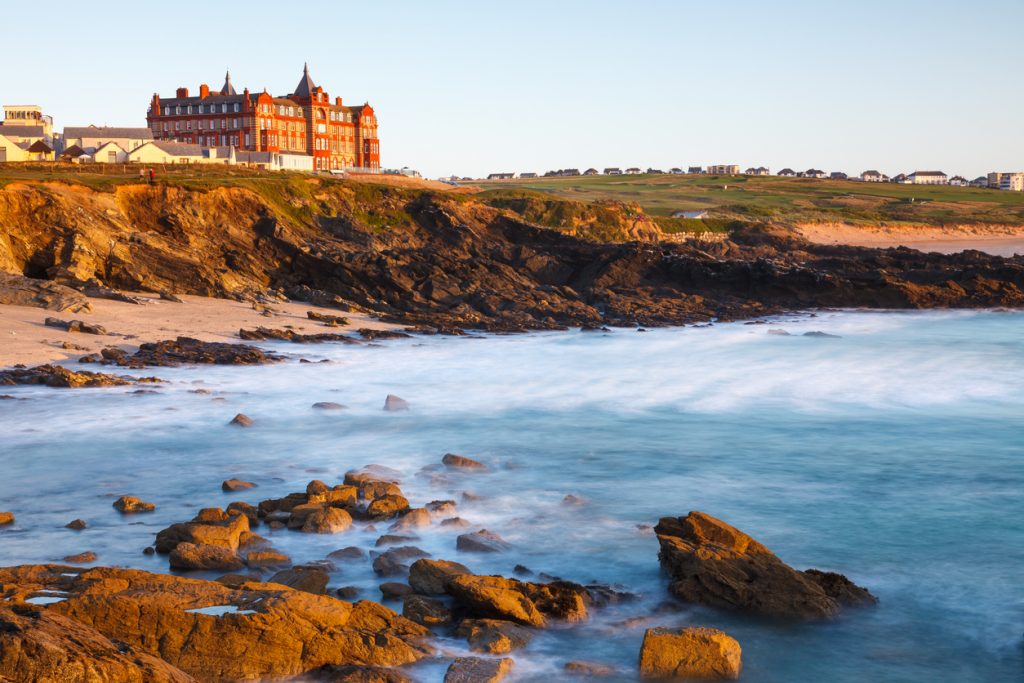
If you’re looking for something fancy and want to soak in a spa when you’ve finished a long day of hiking, I recommend checking out The Headland Hotel and Spa.
This overlooks Fistral Beach, which is popular with surfers in the daytime but quieter in the evening.
Bodmin
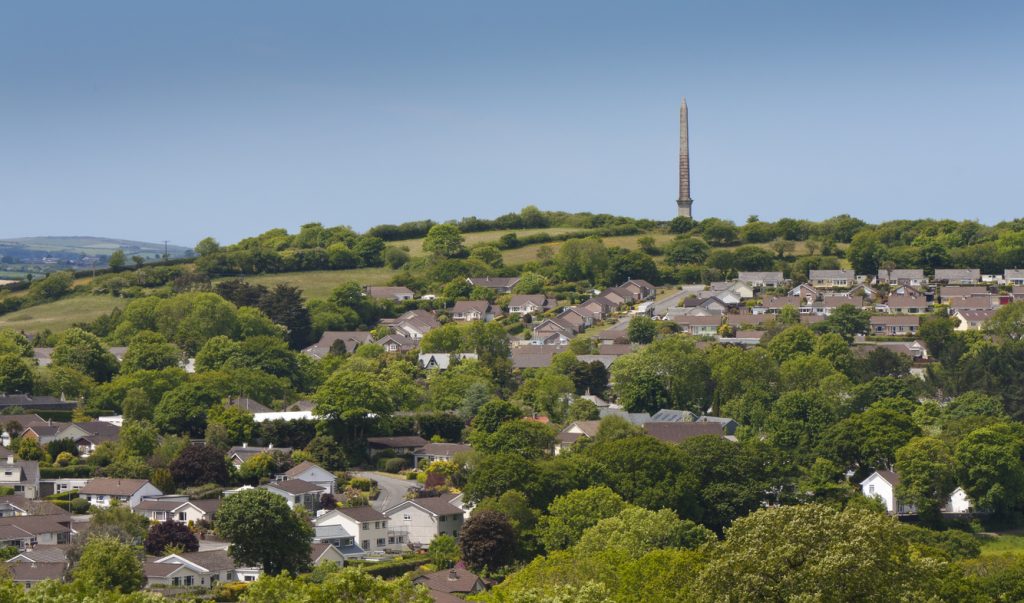
If you want to take in some of the best circular walks in Cornish wilderness, then I’d recommend staying in Bodmin.
Not only is this town one of the most affordable places to stay in Cornwall, but from here you can easily drive to various trailheads on Bodmin Moor for circular hikes.
Bodmin town isn’t anywhere near as quaint as Cornwall’s sleepy fishing villages, but the hotels are affordable and there are quite a few things to do, including Bodmin Jail which is one of my favourite Cornwall attractions.
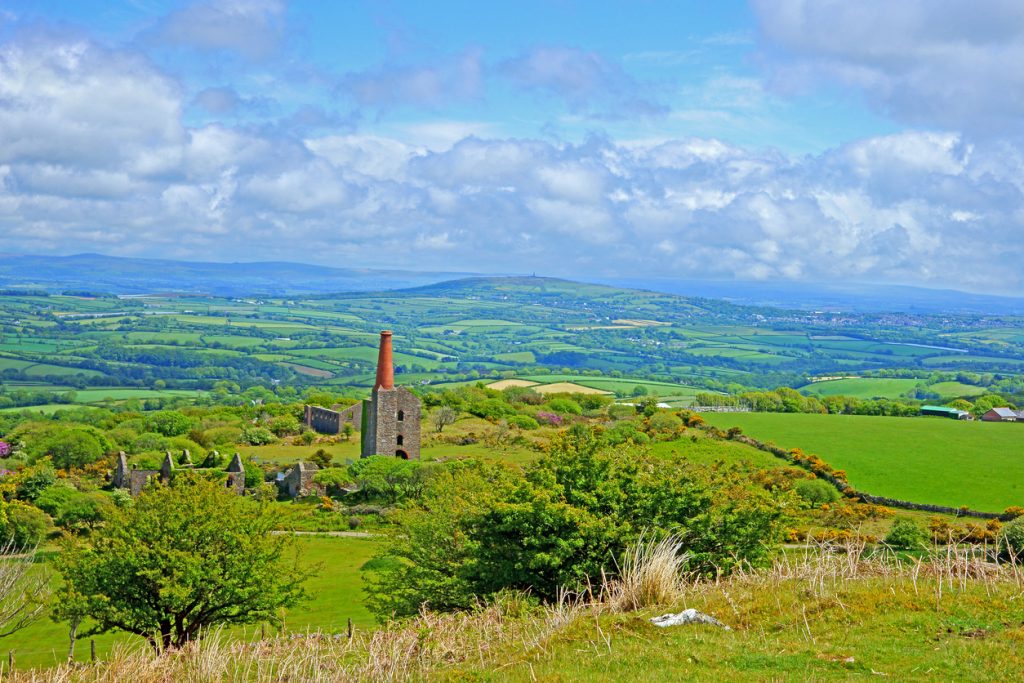
Hotel recommendation for Bodmin
If you’re keen on staying in the heart of Bodmin Moor, then I’d definitely recommend Jamaica Inn.
This is in Bolventor, which is a 15 minute drive from Bodmin town, but it’s right in the middle of the moorland and is a great destination to to some of the trailheads for other Bodmin walks.
Enjoy the historic atmosphere, smuggling connections and restored rooms when you stay here!
Click here to read more about it.
In Bodmin town itself, check out Lanhydrock View, which has friendly staff, comfortable rooms and good value rates. Click here for more information.
Penzance
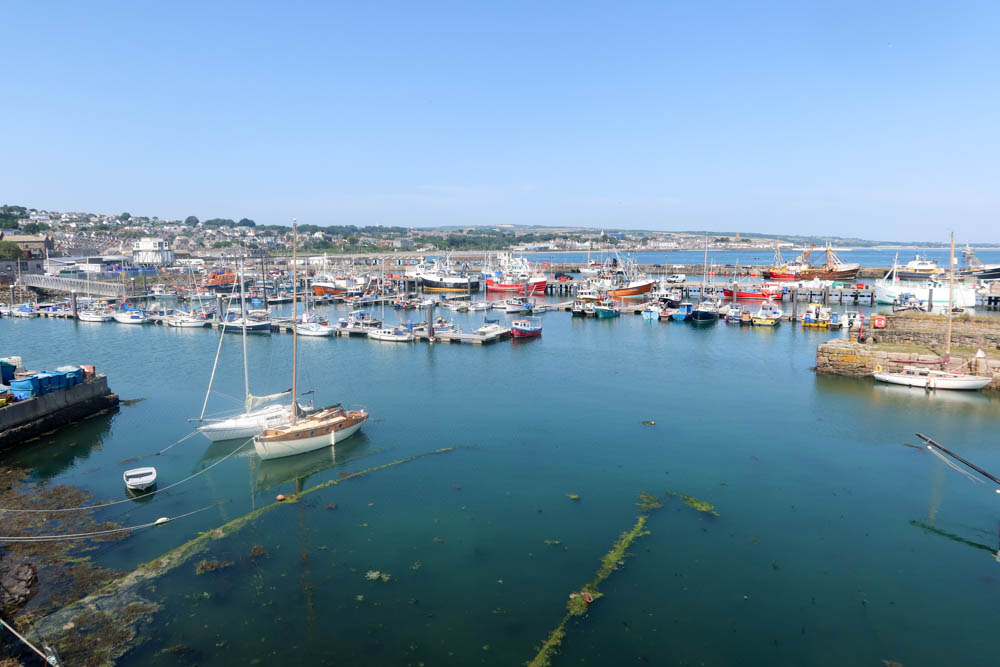
Penzance is a great place to stay if you’re hiking in Cornwall.
The far west Cornish town has rail connections to St Erth (for St Ives), Hayle, Par (you can hike from here or take a train to Newquay) and various other hiking spots.
You can also take the Land’s End coaster from Penzance; which means you can do the whole Penzance to St Ives section of the coast path fairly easily.
Plus, you can even get to Penzance by direct train from London, Bristol, Plymouth and Exeter.
The coastal town isn’t quite as scenic as some of Cornwall’s seaside villages, but it’s still quite charming, with some lovely beaches and things to do.
Plus, hotels in Penzance are more affordable than in smaller villages in Cornwall like nearby Mousehole.
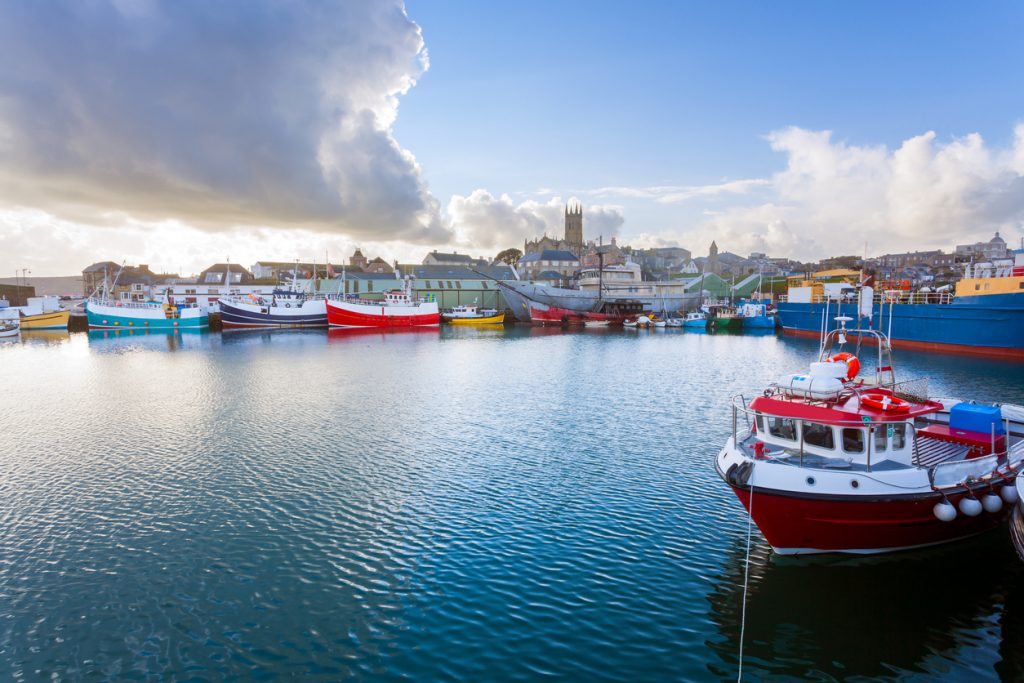
Hotel recommendation for Penzance
The Longboat Inn is a popular favourite in town, with a prime location close to the centre and cosy yet well-facilitated rooms. Click here for more information.
The Lizard Peninsula
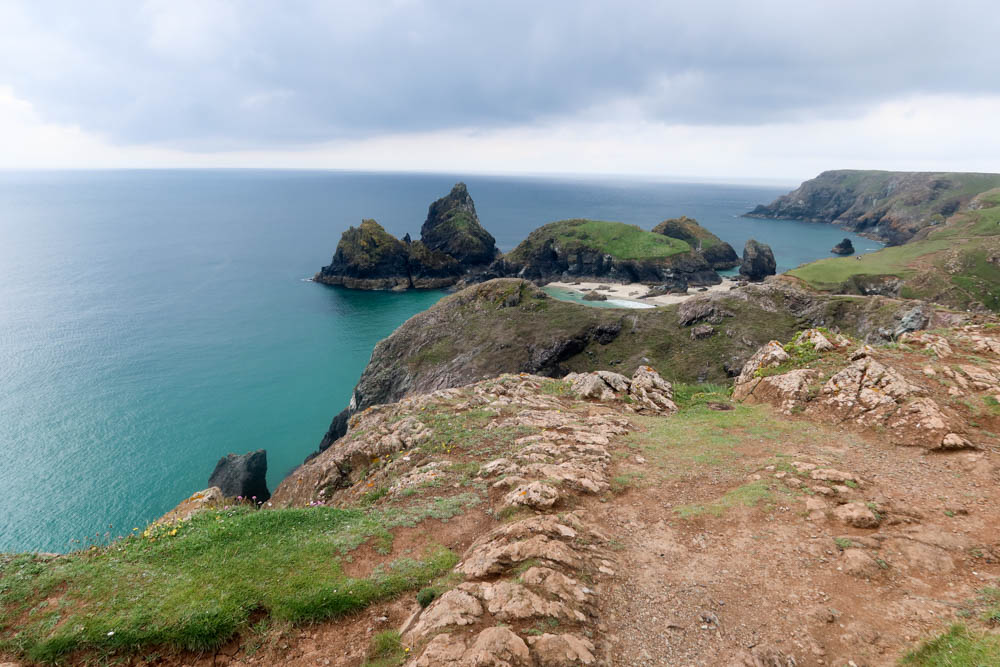
The Lizard Peninsula is a hiker’s dream. The rugged coast path runs around its edge, occasionally descending into coves and beaches like Kynance and Poldhu.
It’s one of the last truly wild and remote areas of Cornwall, and visiting The Lizard gives a glimpse into what the region was like before mass tourism arrived.
Hotel recommendation for the Lizard

To be honest, I’d recommend hiking and camping if you really want to explore the best hikes in the Lizard – it takes 3-5 days to complete the entire path from Porthleven to Falmouth.
However, if you want to stay in a hotel, you could check out Housel Bay Hotel which sits very close to Lizard Point, enjoy hikes in the vicinity (you can turn many hikes into loop walks by journeying back through the countryside), and taking the Lizard Coaster to spots on the west Lizard coast. Click here for more information.
Looe
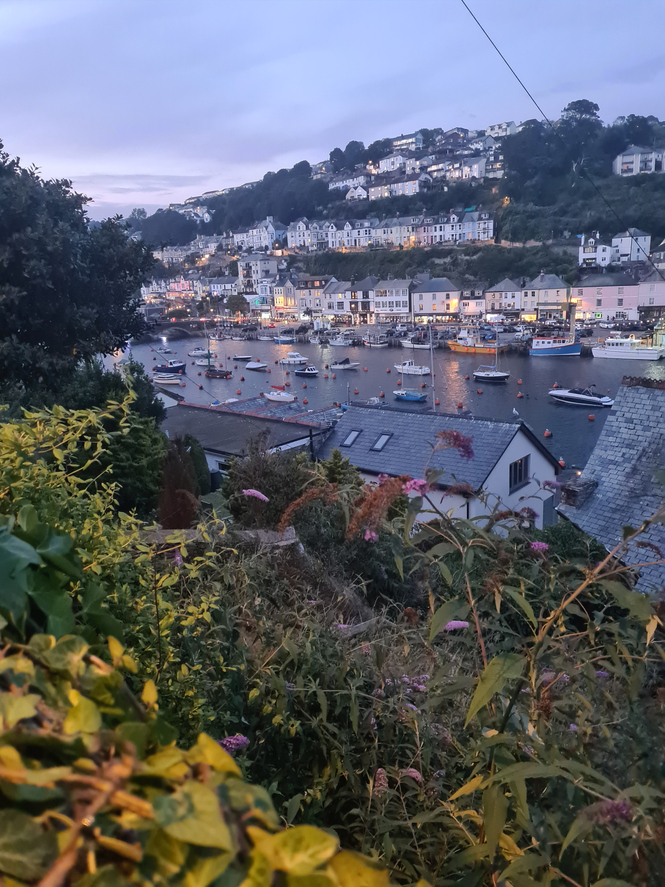
For access to the best hikes in South Cornwall, consider staying in the coastal town of Looe.
With a range of restaurants, hotels and the picturesque estuary and coastline, this is one of the most popular places to stay in Cornwall for any type of traveller.
Hikers can enjoy the South West Coast Path in both directions (to Polperro or Polruan and Portwrinkle), along with the gorgeous Looe Estuary.
There are good bus connections to other south coast towns and villages, along with a scenic railway line to Liskeard, where you can easily connect to Par for hikes in that area.
Plus, there are a few fun things to do in Looe itself.
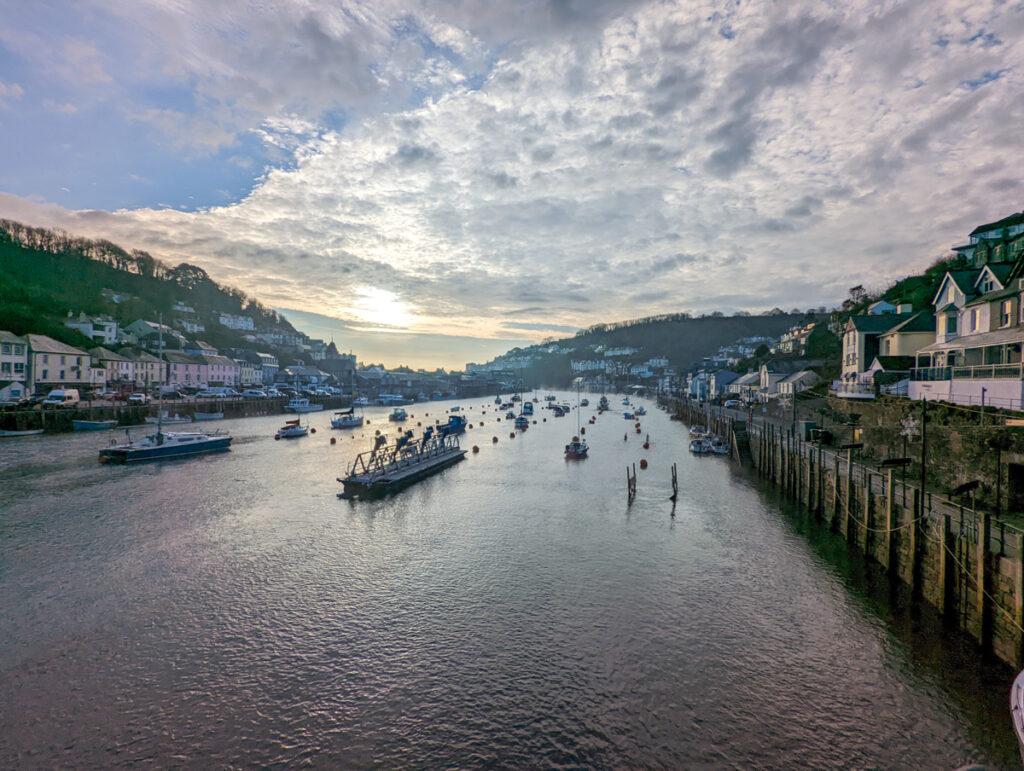
Hotel recommendation for Looe
Shellseekers Guest House is located right on the quay, in easy reach of Looe’s main attractions and the coastal path.
It has cosy rooms, friendly staff and an excellent breakfast each morning – ideal for a busy day of hiking!
Camborne or Redruth
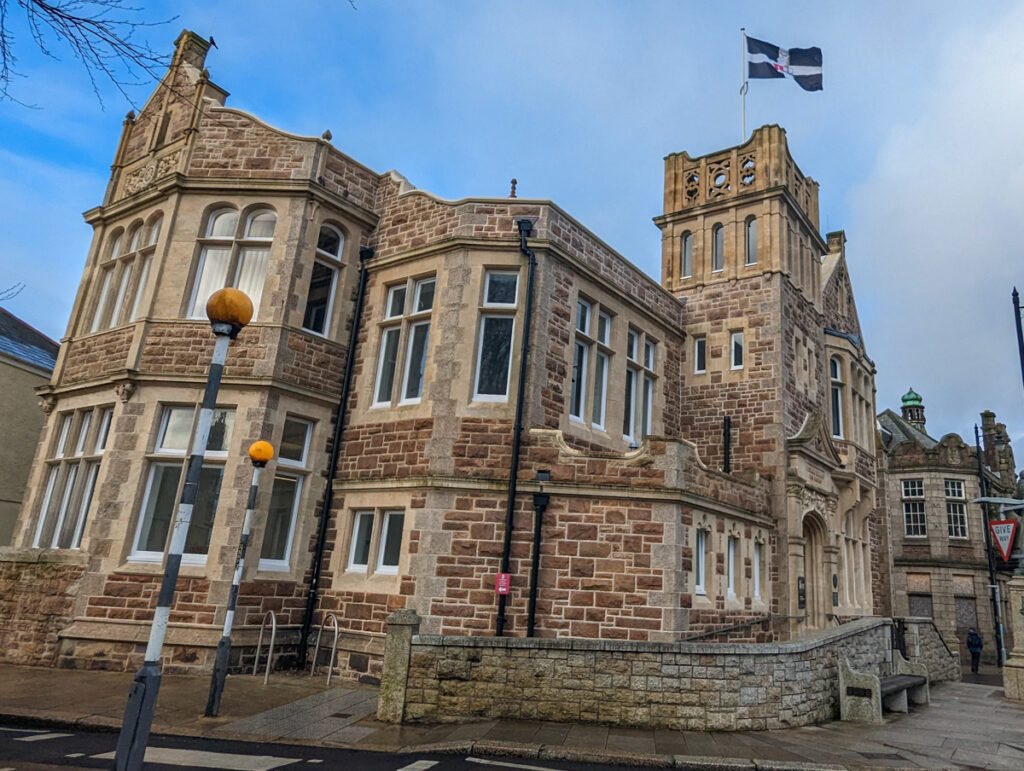
While there aren’t a huge amount of hikes right by Camborne and Redruth, I’d recommend either town as a good place to stay for a Cornish hiking holiday.
This is mainly due to the amount of connections. Both towns have train services on the Cornish main line, which means that they connect with Penzance, St Erth and even Par and Liskeard in South East Cornwall.
You can also take buses to Portreath and Helston.
Hotel recommendation for Camborne and Redruth
Penventon Park Hotel is a Georgian mansion boasting four-star accommodation. Rooms are lavish and the perfect place to relax in after a day of hiking, plus there’s an indoor swimming pool.
It’s just a short walk from here to Redruth station. Click here for more information.
If you’re looking for something more budget-friendly, Camborne has a Wetherspoons Hotel.
Rooms are situated above a Wetherspoons pub; although they are very separate, so you should still be able to get a good night’s sleep!
Click here to read more about it.
Moving from town to town
If you want to move from town to town, I’d recommend just starting somewhere on the Cornish coast path (Bude is the most popular, as it’s the first main town in northern Cornwall) and taking it step by step.
There are accommodation options at most coastal towns, but it’s a good idea to book in advance, especially in the peak summer season.
Lots of hikers camp. There are campsites along the South West Coast Path (and in many other hiking destinations in Cornwall!), and they often have cheaper rates for walk-ins.
Wild camping in Cornwall
Wild camping isn’t legal in Cornwall, but many hikers do it – generally, it’s accepted along the South West Coast Path as long as you behave respectfully and don’t leave any trace of being there.
I’m not recommending anyone does this, but merely passing on the common consensus from the SWCP groups I’m in (and from living in a town that’s on the path!).
You can legally wild camp, however, by asking the landowner for permission.
Of course, it’s not always possible to track down the landowner, but if you want to try wild camping and are concerned about these legalities, then you could always try!
What to pack when hiking in Cornwall
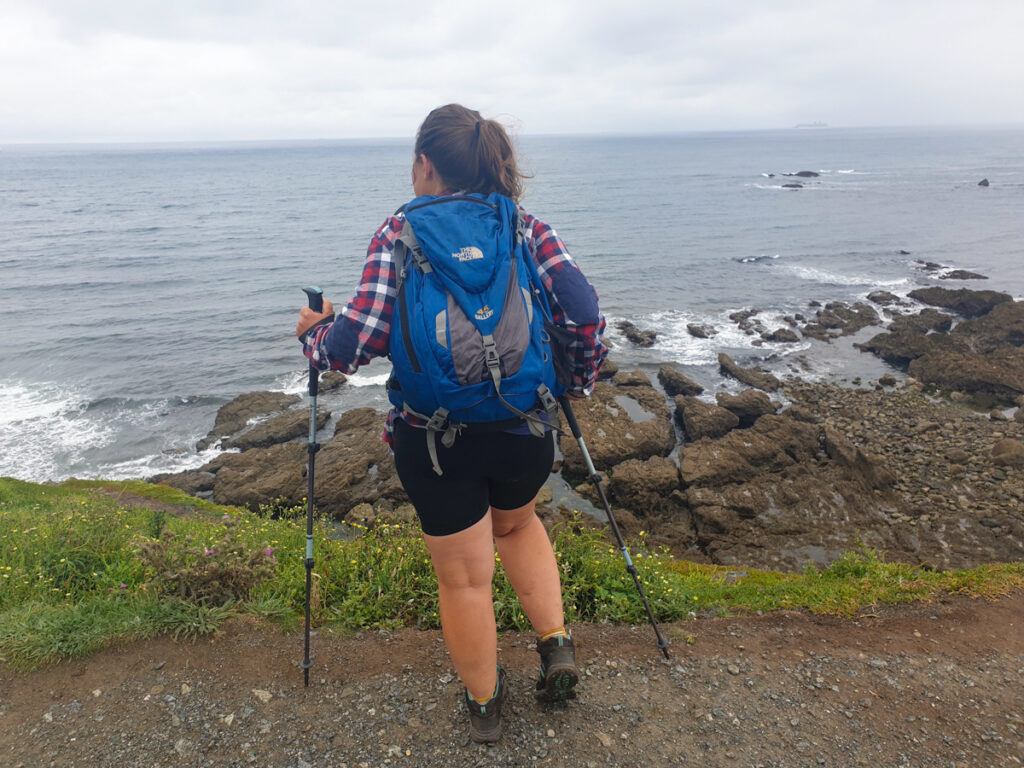
Here’s my tried and tested packing list for hiking in Cornwall – it features everything that we took on our South West Coast Path hike (and a few things that we left out).
Using this list, you should be able to pack successfully for any Cornwall hiking trip, whether it involves the coastal path or moorland, and whether you’re camping or staying in hotels.
Hiking packing list
Here are some things to not forget if you’re hiking, whether you’re camping or not.
Hiking clothes
I wear sports shorts with a baggy top and a sports bra.
If I’m hiking in the winter, I’ll wear leggings or hiking trousers instead of sports shorts and a rain mac or puffer jacket.
Peter Storm does quite good hiking jackets – check one out here.
Shoes
Invest in some decent waterproof shoes – preferably a pair of walking boots although trainers will do if you aren’t hiking for very long. I like Berghaus hiking boots, like these.
Plus, you’ll need hiking socks – I have these Peter Storm ones and they have withstood the test of time (and many hikes!).

Sun protection
Most of the year, I’ll wear a baseball cap, and I’ll always put some factor 50 sunscreen on – from experience, I can tell you that the sun in Cornwall certainly can burn!
Hiking equipment
A strong pair of trekking poles is pretty essential when hiking in Cornwall. You can pick up cheap EuroHike poles like these ones for around £10 each – which are better than nothing.
However, if you’re hiking in North Cornwall or hiking for more than a few days, I’d highly recommend investing in a good quality pair.
We use Black Diamond hiking poles like these ones and love the quality – plus they’ve withstood nearly 1,000 miles of trekking around South West England.
I’d also recommend a robust day bag like this Osprey bag. In my experience, Osprey are super reliable and can withstand a lot of wear and tear.
Safety equipment
I’d recommend packing a first aid kit, along with a head torch. Petzl are a good head torch brand – we have a few and they’ve never let us down. Click here to check out a Petzl head torch.
Electronics
Don’t forget some sort of photo-taking device, whether it’s your phone or a camera. You’ll want to take a few photos, trust me!
Plus, I’d recommend at least one power bank, or possibly more if you’re camping.
Water
Always take enough water with you. I recommend getting a hydration bladder for your backpack if you can – this enables you to quickly drink on the go. This Osprey bladder fits into most bags.
You could also consider a Water to Go Bottle, which means that you can drink fresh water from streams and rivers (but not saltwater from the sea).
I’ve used this bottle both when hiking in the UK and all over the world, and it’s always provided me with safe, clean drinking water.
If you’re hiking in the summer months, a chilly’s bottle will keep your drinks cool, although they are quite heavy.
Camping gear
If you’re camping while hiking, here are my suggestions.
Lightweight tent
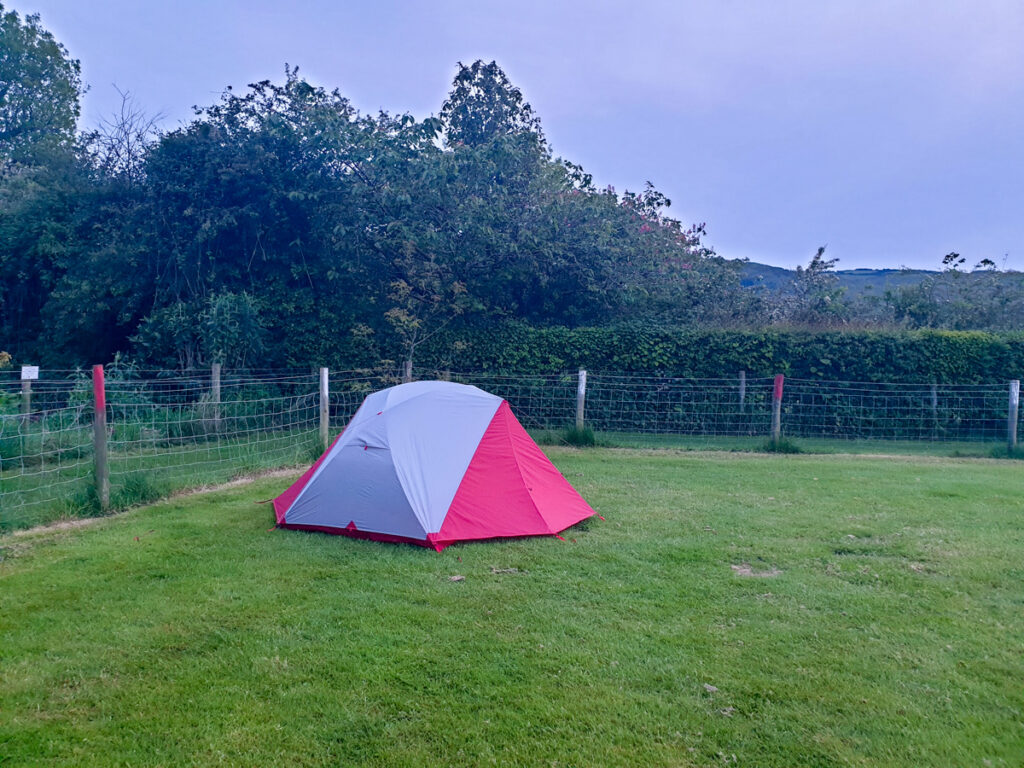
I always use MSR tents, which are fairly lightweight and not too expensive in terms of high-quality lightweight tents.
We have the MSR Elixir 2 tent, which is surprisingly roomy for just the two of us and only weighs 2.27 kg (we split it so we’re both carrying just over 1kg of tent). You can check it out here.
Sleeping mats
I tried roll foam mats at first, but couldn’t get on with them, so I opted for this Vango self-inflating mat. It’s a bit heavier but a whole lot more comfier.
Sleeping bag
Go for something that’s appropriate for the season that you’ll be hiking – you can get two-season, three-season or four-season varieties.
If you’re doing any camping outside of the seasons from May to September, I’d recommend getting a four-season sleeping bag just to be on the safe side.
I have this EuroHike sleeping bag which has always kept me very warm.
Cooking equipment
This adds weight to your bag, but cooking for yourself will save you a lot of money while you’re hiking.
We pack a portable stove, gas canisters, a bowl, plate and cutlery set and mugs (for that all-important morning coffee!)
Entertainment
In the evenings you might want something to do! Pack a kindle or other e-reader (physical books will add a lot of weight!), or bring some playing cards.
Toiletries
Don’t forget soap, shampoo and conditioner, and any other essential toiletries.
Backpack
I always use Osprey backpacks; this is my go-to hiking kit bag.
It has plenty of straps to disperse weight evenly (so it’s comfortable to carry!) and is roomy enough to accommodate camping gear.
If you’re only doing day hikes, you might prefer a smaller day-use bag, or if you’re taking lots of photos, you might want to consider a specific camera backpack for travel.
Cornwall hiking holidays
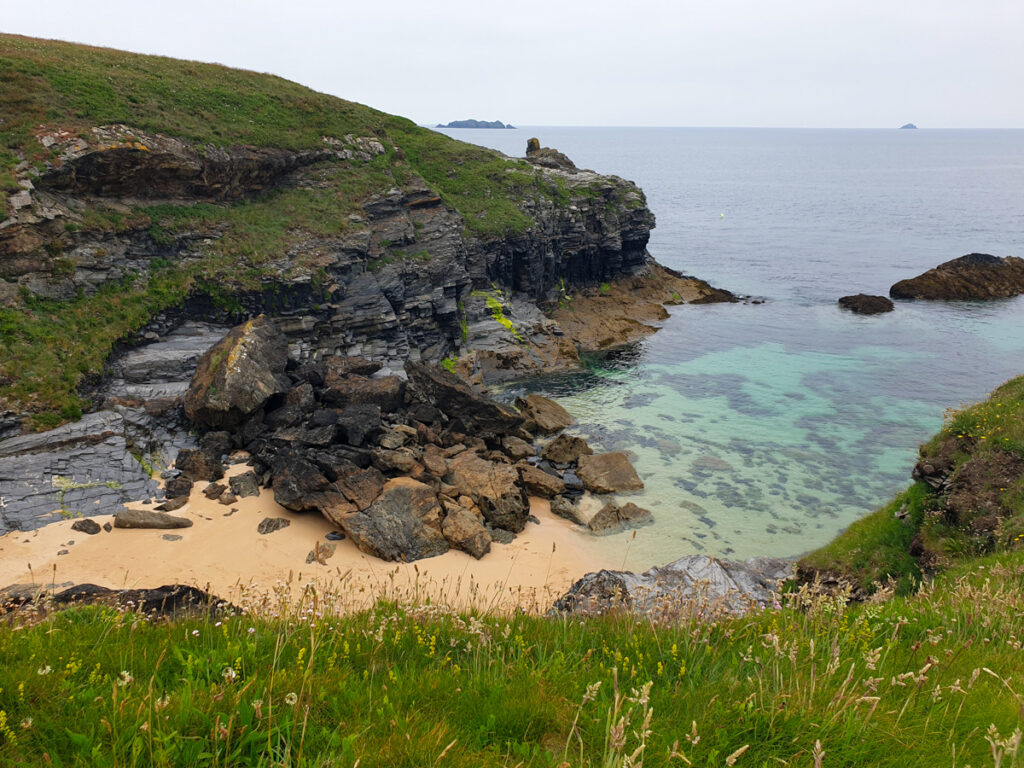
If you don’t fancy journeying around Cornwall independently, there are quite a lot of Cornwall hiking tours and packages that you can join.
There are a few benefits to going on hiking tours or taking a package as opposed to walking solo:
- if on a group tour, you’ll have a chance to make new like-minded friends
- you’ll be with an experienced guide who knows the region or be following instructions
- you won’t need to arrange accommodation each night
- you won’t hike with your bags – these will be transported between accommodations each day
Of course, it does mean that you will have structure and won’t be able to hike completely at your leisure – plus, the hiking tours are out of budget for some.
However, if you’re interested in hiking tours in Cornwall, check out the following:
South West Coast Path Walking North Cornwall Coastline (13 days, 12 nights)

This tour offers the best of both worlds.
The company organises your accommodation and luggage transfers each night, plus provides you with detailed instructions and directions via a pre-loaded map.
However, there’s no actual guide taking you around – which means that you can enjoy the scenes of Cornwall’s northern coast at your own leisure!
This hiking tour starts in Bude and ends in Penzance (which covers most of my favourite parts of the Cornish coast path!), with the option to extend your trip at either end.
Click here for more information about this tour on Viator.
When to hike in Cornwall
You can certainly hike in Cornwall all year round, although some months are better than others. Let’s break it down season by season.
Summer

The most popular time to go hiking in Cornwall, in summer you can enjoy long days and fairly decent weather.
However, I was hiking in Cornwall in June and found some days to be too hot for the relentless coast path hills!
Summer is peak season in Cornwall, and I wouldn’t recommend travelling around the region from the last week of July to the first week of September – it’s so busy and accommodation prices are ridiculously inflated.
However, if you are using campsites, many accept hikers even if the tent spots are over-full.
Generally, June can be a nice time for hiking, but I’d personally avoid July and August.
Autumn
Autumn is a great time to hike in Cornwall!
The days are still fairly long in September, although they shorten quickly in October. Most campsites stay open throughout September and some don’t close until October half term.
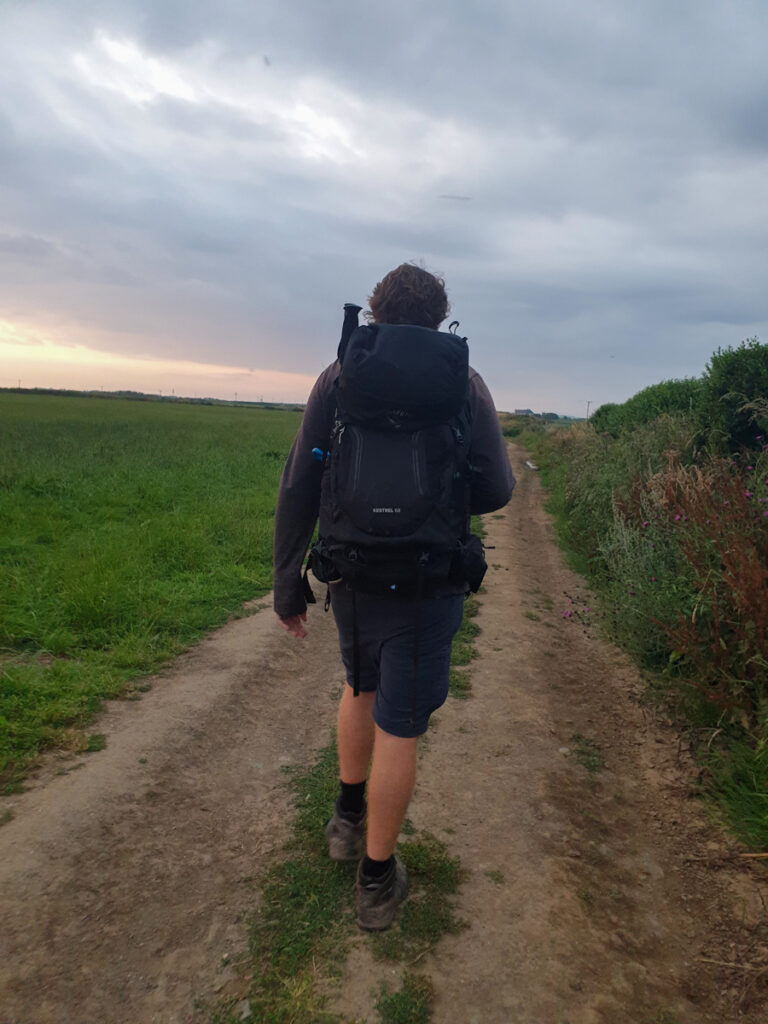
The weather can be mild, and the crowds are much, much thinner than in the summer season. From November onwards, the weather can get quite stormy, so do be mindful of this and don’t hike on the path in strong wind or rain.
Winter
Some people completely avoid the coastal path in the winter months, but I think that’s a shame.
Some of my best Cornish hikes have been in the winter; we did the Rame Peninsula walk last year, and the Looe to Polperro hike this year!
It’s not the time for multi-day hikes, as it’s too cold for most people to consider camping and the weather can be unreliable on a day-by-day basis.
However, find a nice still, brisk day, head to a spot where you can easily get back to your starting place (remember that some buses, like the Atlantic Coaster, don’t run or are on a reduced timetable in winter) and I promise you that you’ll love winter hiking in Cornwall.
Check out my favourite places for Christmas breaks in Cornwall here.
Spring
As the weather warms up, Spring can be a lovely time for hiking in Cornwall.
While the weather can be unsettled throughout March and April (and the Easter Holidays are a busy time in the region), the longer days and milder conditions (plus a chance of lovely sunny weather) mean that both day hikes and multi-day treks are back on the cards in May.
If you want to avoid crowds and being to hot when hiking, try a hiking holiday in late April or early May.
All you need to know about Cornwall hiking!
From the mighty cliffs of the Cornish coastline to the craggy landscapes on moody moors, hiking in Cornwall is an experience that you won’t forget in a hurry.
One of the best things to do in the region is to enjoy its natural landscape, and hiking immerses you right into it.
Don’t forget to check out my Cornwall archives if you want more information about exploring this dynamic region, and if you have any questions feel free to drop me a message over on Instagram.

